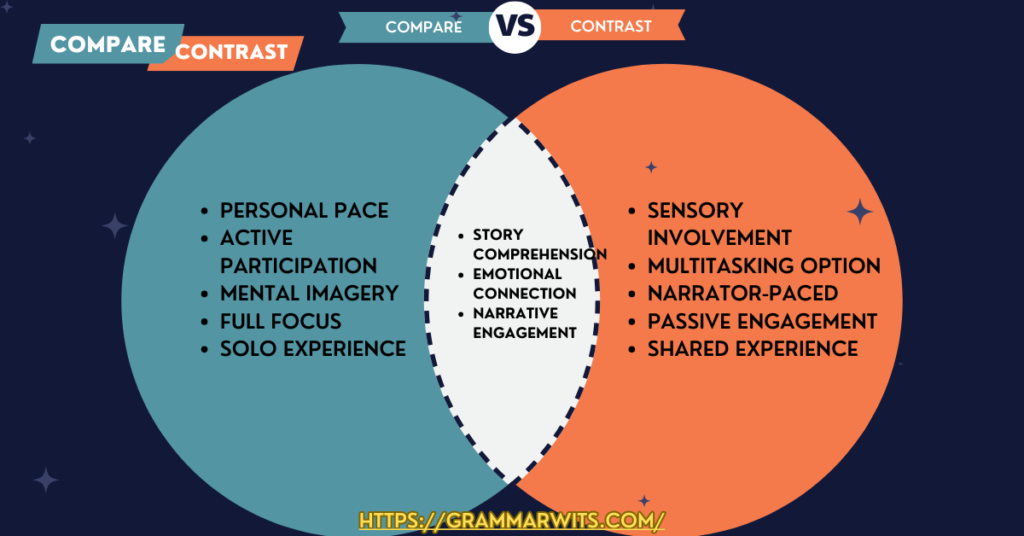The terms “compare” and “contrast” are often used interchangeably, yet compare vs contrast definitions differences serve distinct purposes in both written and verbal communication. Comparing refers to examining the similarities between two or more items, people, or ideas, highlighting how they align. On the other hand, contrasting focuses on identifying the differences, emphasizing what sets these subjects apart. Both are essential tools in critical thinking and analysis, helping us make informed decisions and communicate ideas more effectively.
Understanding the compare vs contrast definitions differences is essential for anyone looking to analyze two subjects effectively.
Understanding the difference between these two concepts can transform how we approach everything from product reviews to academic essays. Whether you’re comparing two cars for purchase or contrasting the philosophies of two historical figures, knowing how to use compare vs contrast techniques can elevate your analytical and writing skills.
The differences between compare and contrast aren’t just limited to their definitions but also extend to their methods of application. While comparison looks for commonalities, contrast digs into distinctions. Recognizing these differences will allow you to use both techniques more strategically, enhancing the clarity and depth of your analyses.
What Does the Word “Compare” Mean?
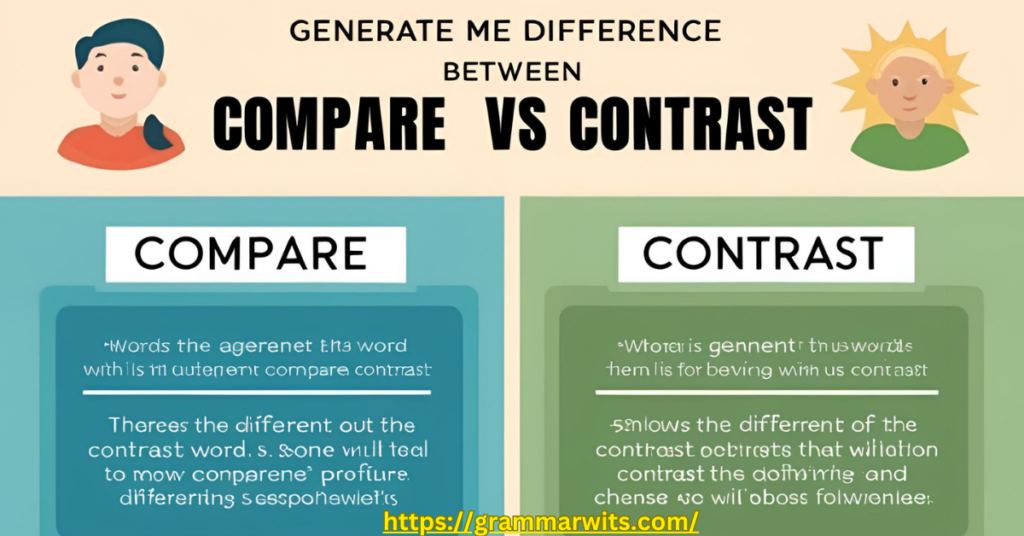
Comparing refers to the act of examining two or more items, ideas, or situations to highlight their similarities. The word “compare” comes from the Latin “comparare”, meaning to pair together or match. It involves an analysis that focuses on identifying common characteristics or shared attributes between the subjects being examined. In a comparison, you are not merely listing traits; you are exploring how the items are alike or relate to each other in specific contexts.
By grasping the compare vs contrast definitions differences, writers can choose the right technique for their analysis.
In its most basic form, comparing allows you to analyze two subjects side by side to reveal their commonalities. For instance, when comparing two cars, you might look at their engine size, fuel efficiency, and price range. These similarities help you decide which vehicle better fits your needs. Comparing isn’t restricted to physical traits alone; you might compare the ideas presented in two essays, looking for shared themes, philosophical stances, or arguments.
By focusing on similarities, comparison enables you to make informed decisions, provide insight, or simply better understand how two or more items are related. When used effectively, comparison enhances critical thinking and supports evaluation by pinpointing what works best in a given situation.
What Does the Word “Contrast” Mean?
In contrast, contrast involves highlighting the differences between two or more subjects. The word “contrast” derives from the Latin “contra” meaning “against” and “stare” meaning “to stand.” The essence of contrast is to examine how two or more items diverge from one another. Unlike comparison, which seeks to find common ground, contrasting emphasizes distinctive characteristics that make each item unique.
The compare vs contrast definitions differences can help you organize your thoughts and present your arguments more clearly.
When contrasting, the focus shifts from commonality to dissimilarity. For example, when contrasting two smartphones, you might analyze differences in design, operating system, battery life, and price. The goal is not to show how the phones are similar but rather to highlight what sets them apart. Contrast often plays a key role in decision-making, particularly when evaluating options or alternatives. When contrasting personalities of two individuals, you might explore their temperaments, communication styles, and interests, all of which distinguish them from one another.
Contrast is essential when you want to understand opposing elements or assess the unique qualities of subjects. Whether you’re studying literature, debating ideas, or comparing products, the power of contrast lies in its ability to reveal how things stand apart, allowing for deeper insight into their individual features.
Quick Summary
To compare involves identifying the shared characteristics between two or more things, often emphasizing what they have in common. This can be done by using words like "similarly," "both," or "alike." For instance, comparing two cars might involve pointing out that both offer excellent fuel efficiency and comfortable seating. On the other hand, contrasting focuses on the differences between the items being discussed. This process highlights unique features that set them apart, using phrases like "in contrast," "unlike," or "on the other hand." For example, contrasting two restaurants might involve noting that one specializes in fine dining, while the other offers fast casual meals with a focus on local ingredients.“Compare” vs “Contrast”: The Differences
While the words compare and contrast are closely related, they serve different purposes and focus on different aspects of analysis. Understanding the differences can help you use these concepts more effectively.
- Purpose:
- Compare: The main purpose of comparing is to identify similarities. When you compare two subjects, you’re exploring how they are alike, looking for patterns, shared features, or common ground. This could involve anything from the design elements of two websites to the thematic similarities in two novels.
- Contrast: The purpose of contrast is to highlight differences. When contrasting, you’re interested in what makes the subjects distinct from one another. Contrasting allows you to examine opposing qualities, such as the difference between two political candidates’ policies or how two historical events unfolded differently.
- Focus:
- Compare: When comparing, the focus is primarily on shared traits, features, or attributes. For instance, in the case of comparing two smartphones, you might focus on how both devices offer similar performance in terms of processing speed, camera resolution, and operating system functionality.
- Contrast: In contrast, the focus lies on distinguishing one subject from another. If you’re contrasting those same smartphones, you’d point out how one has a larger screen, longer battery life, and is more affordable, while the other offers superior graphics, better camera features, and a more expensive price tag.
- Method:
- Comparison often uses a juxtaposition method, where similarities are placed side by side for easy identification. You may look at multiple characteristics of each subject and explore how they compare across the board.
- Contrast, on the other hand, requires you to spot distinctions between the subjects. Often, this method involves focusing on unique features or attributes that clearly differentiate one subject from another.
By understanding these differences, you can decide when to compare and when to contrast in writing, decision-making, or even literary analysis.
Examples in Context
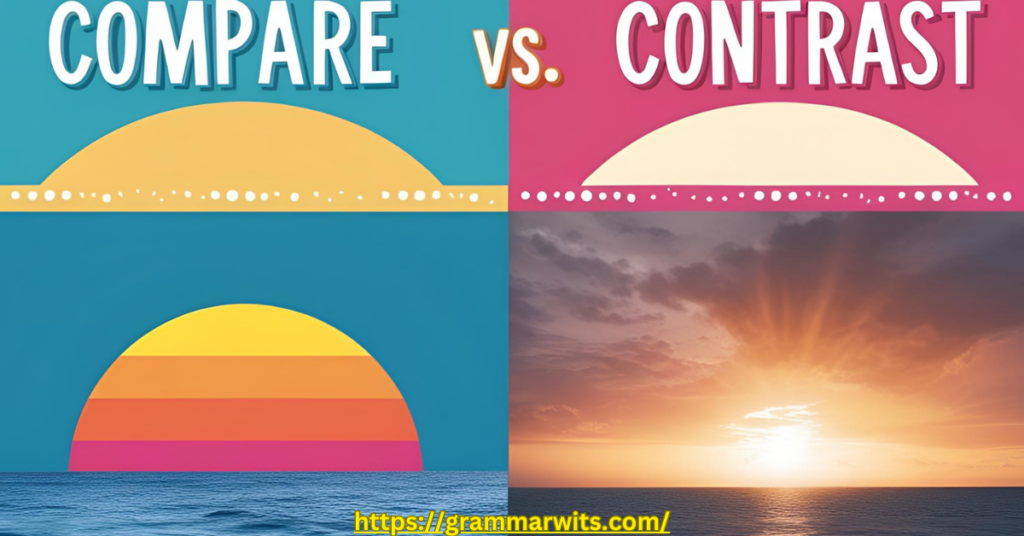
To clarify how compare and contrast function in various contexts, let’s explore examples from different domains, including literature, technology, and daily life.
Compare:
- Two Smartphones: If you’re comparing two smartphones, you might look at common features like screen size, camera resolution, and operating systems. You could also compare how each phone handles multitasking, runs applications, or supports wireless charging. The goal here is to determine which phone has more shared advantages or aligns better with your preferences.
- Two Movies: In comparing two movies, you might examine their plot structure, themes, and visual effects. Both might share a genre (e.g., science fiction), and by comparing them, you can identify whether one film presents more compelling characters or offers a more coherent narrative, depending on your preferences.
- Two Cars: When comparing vehicles, you look at fuel efficiency, safety features, interior design, and brand reputation. This helps to understand which vehicle offers a better value for money, better features, or higher satisfaction based on shared qualities.
- Comparing two books: “Both novels explore themes of love and loss.”
- Explanation: These books deal with similar emotional topics, focusing on relationships and grief.
- Comparing two restaurants: “Both offer vegan menu options.”
- Explanation: The restaurants cater to vegan diets, providing plant-based meal choices.
- Comparing two athletes: “Both players excel in basketball defense.”
- Explanation: Both athletes are known for their exceptional skills in protecting the basket.
- Comparing two vacation destinations: “Both locations have beautiful beaches.”
- Explanation: The destinations are famous for their scenic coastal views and sandy shores.
Contrast:
- Two Smartphones: When contrasting smartphones, you focus on what sets them apart. For instance, one phone might have a better camera, while the other has a larger battery. The price, user experience, and operating system could also play a significant role in distinguishing the two devices.
- Two Novels: If you contrast two novels, you’d highlight how the writing style differs, the tone of the narrative, or how the authors tackle social issues. For instance, one novel might be dystopian while the other is realistic fiction.
- Two Historical Events: Contrast can also apply to historical events. For example, you might contrast the American Revolution and the French Revolution, focusing on their causes, leaders, and outcomes. The approach to each revolution (military vs. political) and the global impact would further help to show their distinctiveness.
- Contrasting two books: “The first book is set in a dystopian future, while the second takes place in a historical setting.”
- Explanation: One book is centered on a speculative world, while the other reflects past events.
- Contrasting two vacation destinations: “Hawaii offers tropical beaches, whereas the Swiss Alps are known for their snowy mountains.”
- Explanation: One destination is beach-focused, while the other is ideal for winter sports.
- Contrasting two athletes: “LeBron James is known for his basketball skills, while Usain Bolt is famous for his speed on the track.”
- Explanation: One athlete excels in basketball, and the other is a world-renowned sprinter.
- Contrasting two cars: “The electric car is eco-friendly, while the gas-powered car provides longer driving range.”
- Explanation: One car emphasizes sustainability, while the other offers practicality for long-distance
Synonyms of “Compare” and “Contrast”
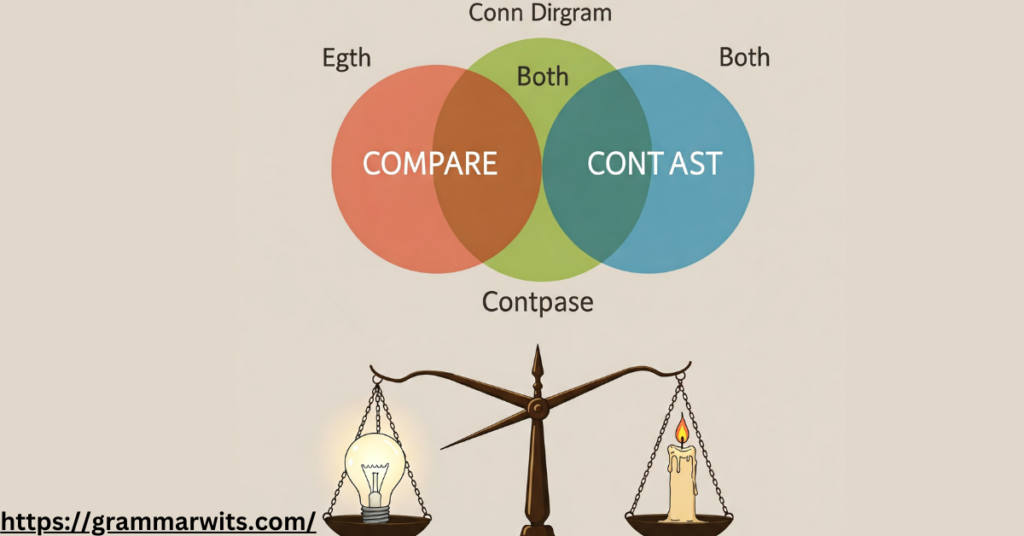
To avoid repetition in writing, using synonyms for compare and contrast can enhance your writing. Let’s dive into some common alternatives.
Synonyms for “Compare”:
- Equate: To treat as equal, often used when you draw direct connections.
- Example: Equating these two art styles reveals their shared emphasis on abstraction.
- Match: Suggests a pairing based on similarity.
- Example: The criteria for this contest match the applicants’ skills perfectly.
- Relate: Establish a connection between things.
- Example: The artist relates her work to the emotional struggles of life.
- Align: To bring into agreement or harmony.
- Example: Their views align with the company’s core values.
- Associate: To link or connect based on shared attributes.
- Example: Many people associate autumn with harvest festivals.
Synonyms for “Contrast”:
- Differentiate: To make the differences clear.
- Example: The two theories differentiate sharply in their approach to education.
- Distinguish: To set apart based on unique qualities.
- Example: Their cultural backgrounds distinguish them from one another.
- Oppose: To contrast in a way that highlights direct opposition.
- Example: Their political views oppose one another in almost every regard.
- Diverge: To move away from each other or to separate.
- Example: The paths of the two artists diverge after their initial collaboration.
- Disagree: To show differences, particularly in viewpoints or opinions.
- Example: They disagree on the methods to achieve success.
Origins of the Words “Compare” and “Contrast”
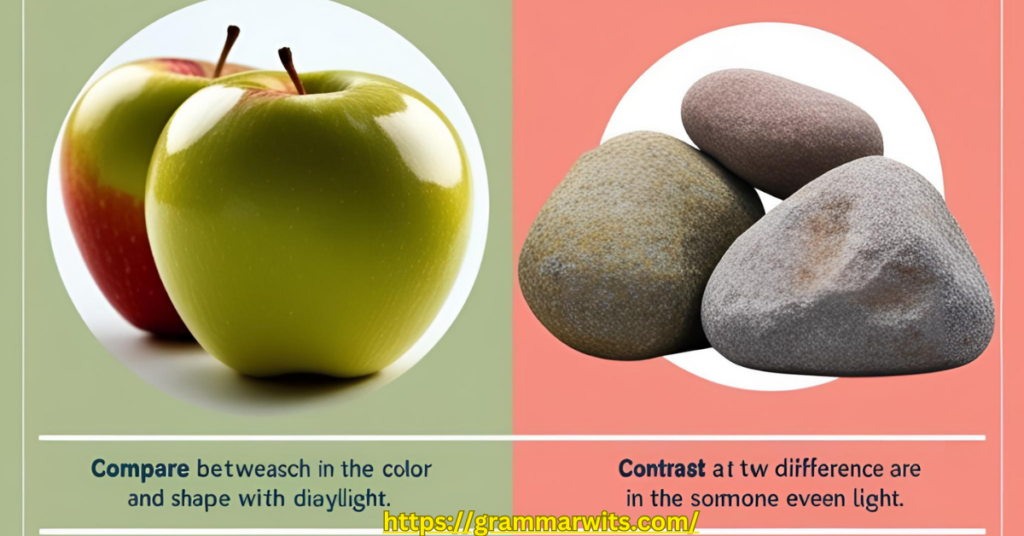
A deeper understanding of word origins can clarify their meanings and applications.
Origins of the Word “Compare”
The word “compare” originates from the Latin word “comparare,” which means “to pair together” or “to make equal.” This is derived from “com-“ meaning “together” and “parare,” meaning “to prepare” or “to make.” Over time, it evolved in English to mean examining two or more things to identify similarities or differences. The concept of comparison has deep roots in human reasoning, often used to evaluate and make judgments by highlighting common features or qualities between objects or ideas. In academic writing, knowing the compare vs contrast definitions differences allows you to create more focused and persuasive essays.
Origins of the Word “Contrast”
The word “contrast” comes from the Latin word “contrastare,” which is a combination of “contra-“ meaning “against” and “stare” meaning “to stand.” This term originally meant “to stand against” or “to oppose,” emphasizing the difference or opposition between two things. In English, it evolved to signify the act of comparing two items to highlight their distinct differences. The idea of contrast focuses on examining opposing features or qualities, often used to draw clear distinctions between objects, ideas, or concepts. The compare vs contrast definitions differences are vital when evaluating similar and opposing viewpoints in debates or discussions.
Applications of Compare and Contrast in Everyday Life
The ability to compare and contrast is crucial in daily decision-making, helping us make informed choices. Whether you’re deciding between two products, planning a trip, or choosing between job offers, comparing the pros and cons of each option helps clarify which choice best suits your needs. In relationships, comparing and contrasting can aid in understanding differences in personality, preferences, or communication styles. This skill also plays a key role in problem-solving, as contrasting various approaches or solutions allows us to evaluate their potential outcomes effectively. By honing this skill, individuals can make better decisions in all aspects of life, from personal to professional.
Compare and Contrast in Literature and Art
In literature and art, the technique of compare and contrast is frequently used to analyze characters, themes, and styles. Writers and critics often compare protagonists or opposing forces to highlight moral or thematic differences. For example, comparing characters’ motivations and actions can shed light on their growth or moral dilemmas. In art, contrasting styles, color schemes, or techniques between artists or periods helps viewers appreciate the evolution of creativity and the unique elements of each work. This approach not only deepens understanding but also enriches the experience of interpreting and critiquing various forms of artistic expression.
Compare and Contrast in Decision-Making and Problem Solving
In decision-making and problem-solving, the skill to compare and contrast is invaluable. It allows individuals to weigh different options by identifying the similarities and differences between them. For example, when faced with a career change, comparing the benefits of each opportunity—salary, location, job satisfaction—helps clarify which option aligns best with personal goals. Similarly, contrasting potential solutions to a problem helps in evaluating the most effective approach. By analyzing the pros and cons of each choice, we can make more rational and informed decisions, reducing uncertainty and minimizing risks. This method is often used in strategic planning, negotiations, and any scenario that requires careful thought and evaluation.
FAQs
1. What’s the difference between comparing and contrasting?
Comparing focuses on similarities, while contrasting highlights the differences between two or more items.
2. Can I compare and contrast in the same essay?
Yes, you can compare and contrast in the same essay, often using a structured approach to show both similarities and differences.
3. What are some common examples of comparison?
Comparing two brands of smartphones, such as the iPhone and Samsung Galaxy, would focus on their similar features like screen size or battery life.
4. What is the purpose of contrasting in writing?
Contrasting helps to emphasize the differences between two things, providing clarity and making distinctions easier to understand.
5. How do I structure a compare vs contrast essay?
Typically, you can structure it by discussing one subject at a time (point-by-point) or by comparing and contrasting specific features in each paragraph (block method).
Conclusion
In conclusion, understanding the compare vs contrast definitions differences is crucial for effective communication. By recognizing when to compare and when to contrast, you can provide clearer insights and more thorough analyses. Comparing highlights similarities, while contrasting shows differences. Both techniques are powerful in various contexts, from writing to decision-making.
The compare vs contrast definitions differences help refine your critical thinking and writing skills. Whether you’re writing essays, making decisions, or analyzing situations, knowing when to use each approach can strengthen your arguments. Embrace these strategies to make your comparisons and contrasts more precise and impactful.

Alizy Smith is a passionate language enthusiast and the admin of Grammar Wits. With a love for wordplay, grammar quirks, and witty expressions, she’s dedicated to making language learning fun and accessible. From grammar tips to pun-filled laughs, Alizy ensures every piece of content entertains while educating — turning tricky rules into easy, enjoyable reads.
